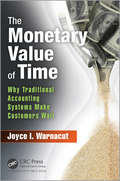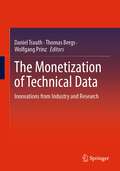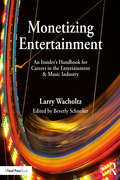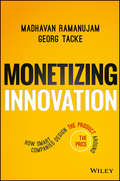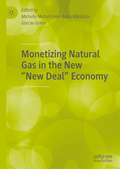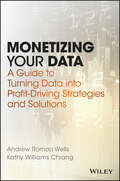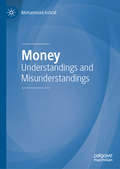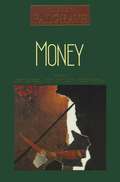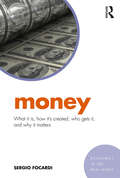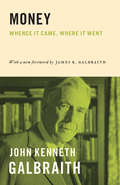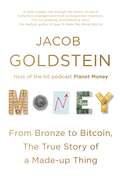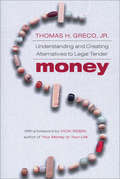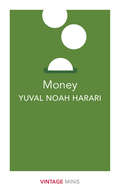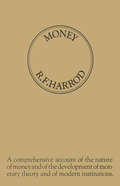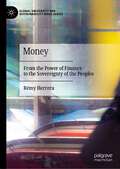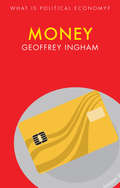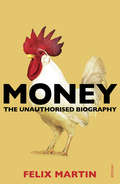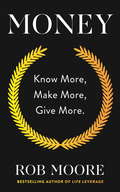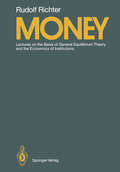- Table View
- List View
The Monetary Value of Time: Why Traditional Accounting Systems Make Customers Wait
by Joyce I. WarnacutAlthough there are numerous books on alternative accounting methods, such as Lean accounting, none focus on the impact of time and how accounting practices can be modified to acknowledge the power of time. This book addresses this need.The Monetary Value of Time: Why Traditional Accounting Systems Make Customers Wait presents a framework for assessing the value of time in terms of organizational strategy and competitive advantage. The framework presented will enable organizations to develop consistent measures and ensure that their cost accounting system isn’t motivating behaviors that add to lead time and make customers wait.The framework outlined in this book is relevant to the managerial and cost accounting practices in today’s manufacturing environment, which is increasingly moving away from mass production to custom manufacturing. The framework is supported by high-level metrics, which are reinforced by operational metrics. This is supported by accounting data that recognize the value of time. Pricing models that incorporate the concept of time are presented. The book provides many examples of how the use of standard costing and traditional accounting practices in a high-mix/low-volume production environment can produce contradictory or even inaccurate results that form the basis for poor decisions that may actually move your organization farther from its objectives.The book arms readers with options for overcoming traditional barriers by applying direct costs at an item level, while applying overheads at a macro or value stream level. For example, while GAAP requires overhead application for inventory valuation, a common misconception is that overhead must be applied at an item level. In fact, overhead can be absorbed by one journal entry. Demonstrating the linkages between time-based accounting data and meaningful business metrics that drive bottom line results, the book presents methods and metrics that have been successfully applied by the author in manufacturing environments.
The Monetary Value of Time: Why Traditional Accounting Systems Make Customers Wait
by Joyce I. WarnacutAlthough there are numerous books on alternative accounting methods, such as Lean accounting, none focus on the impact of time and how accounting practices can be modified to acknowledge the power of time. This book addresses this need.The Monetary Value of Time: Why Traditional Accounting Systems Make Customers Wait presents a framework for assessing the value of time in terms of organizational strategy and competitive advantage. The framework presented will enable organizations to develop consistent measures and ensure that their cost accounting system isn’t motivating behaviors that add to lead time and make customers wait.The framework outlined in this book is relevant to the managerial and cost accounting practices in today’s manufacturing environment, which is increasingly moving away from mass production to custom manufacturing. The framework is supported by high-level metrics, which are reinforced by operational metrics. This is supported by accounting data that recognize the value of time. Pricing models that incorporate the concept of time are presented. The book provides many examples of how the use of standard costing and traditional accounting practices in a high-mix/low-volume production environment can produce contradictory or even inaccurate results that form the basis for poor decisions that may actually move your organization farther from its objectives.The book arms readers with options for overcoming traditional barriers by applying direct costs at an item level, while applying overheads at a macro or value stream level. For example, while GAAP requires overhead application for inventory valuation, a common misconception is that overhead must be applied at an item level. In fact, overhead can be absorbed by one journal entry. Demonstrating the linkages between time-based accounting data and meaningful business metrics that drive bottom line results, the book presents methods and metrics that have been successfully applied by the author in manufacturing environments.
The Monetization of Technical Data: Innovations from Industry and Research
by Daniel Trauth Thomas Bergs Wolfgang PrinzThe monetization of data is a very young topic, for which there are only very few case studies. There is a lack of strategy or concept that shows decision-makers the way into the monetization of data, especially those who have discovered or are threatened by the digital transformation or Industry 4.0. Because machine data is usually unstructured and not usable without domain knowledge/metadata, the monetization of machine data has an as yet unquantifiable potential. In order to make this potential tangible, this work describes not only contributions from science, but also practical examples from industry. Based on different examples from various industries, the reader can already become part of a future data economy today. Values and benefits are described in detail. The translation was done with the help of artificial intelligence. A subsequent human revision was done primarily in terms of content.
Monetizing Entertainment: An Insider's Handbook for Careers in the Entertainment & Music Industry
by Larry WacholtzMonetizing Entertainment: An Insider's Handbook for Careers in the Entertainment & Music Industry offers a thorough, guided exploration of the current state of the industry, with an emphasis on trends in copyright, digital streaming, and practical advice for developing a career as an artist, technician, or industry executive. This book investigates a variety of topics within the entertainment and music industry, ranging from traditional and emerging business models to intellectual property rights to the creative destruction happening currently. The book strategically outlines the existing gaps that make being successful as an artist a dynamic interaction between creativity and business. This book includes the following: An overview of the creative destruction process that has destroyed some of the old business models and created a number of career options. A look at innovative, entrepreneurial career options. A step-by-step examination for both creative and business professionals of the administrative and financial structures of the industry. Detailed analysis of trends and topics shaping the current entertainment and music industry drawn from insiders' perspectives and other contemporary resources. An accompanying website (www.routledge.com/cw/wacholtz), hosting case studies, videos, data, infographics, and blog posts on business models, is the perfect companion to this authoritative resource.
Monetizing Entertainment: An Insider's Handbook for Careers in the Entertainment & Music Industry
by Larry WacholtzMonetizing Entertainment: An Insider's Handbook for Careers in the Entertainment & Music Industry offers a thorough, guided exploration of the current state of the industry, with an emphasis on trends in copyright, digital streaming, and practical advice for developing a career as an artist, technician, or industry executive. This book investigates a variety of topics within the entertainment and music industry, ranging from traditional and emerging business models to intellectual property rights to the creative destruction happening currently. The book strategically outlines the existing gaps that make being successful as an artist a dynamic interaction between creativity and business. This book includes the following: An overview of the creative destruction process that has destroyed some of the old business models and created a number of career options. A look at innovative, entrepreneurial career options. A step-by-step examination for both creative and business professionals of the administrative and financial structures of the industry. Detailed analysis of trends and topics shaping the current entertainment and music industry drawn from insiders' perspectives and other contemporary resources. An accompanying website (www.routledge.com/cw/wacholtz), hosting case studies, videos, data, infographics, and blog posts on business models, is the perfect companion to this authoritative resource.
Monetizing Innovation: How Smart Companies Design the Product Around the Price
by Madhavan Ramanujam Georg TackeSurprising rules for successful monetization Innovation is the most important driver of growth. Today, more than ever, companies need to innovate to survive. But successful innovation—measured in dollars and cents—is a very hard target to hit. Companies obsess over being creative and innovative and spend significant time and expense in designing and building products, yet struggle to monetize them: 72% of innovations fail to meet their financial targets—or fail entirely. Many companies have come to accept that a high failure rate, and the billions of dollars lost annually, is just the cost of doing business. Monetizing Innovations argues that this is tragic, wasteful, and wrong. Radically improving the odds that your innovation will succeed is just a matter of removing the guesswork. That happens when you put customer demand and willingness to pay in the driver seat—when you design the product around the price. It’s a new paradigm, and that opens the door to true game change: You can stop hoping to monetize, and start knowing that you will. The authors at Simon Kucher know what they’re talking about. As the world’s premier pricing and monetization consulting services company, with 800 professionals in 30 cities around the globe, they have helped clients ranging from massive pharmaceuticals to fast-growing startups find success. In Monetizing Innovation, they distil the lessons of thirty years and over 10,000 projects into a practical, nine-step approach. Whether you are a CEO, executive leadership, or part of the team responsible for innovation and new product development, this book is for you, with special sections and checklist-driven summaries to make monetizing innovation part of your company’s DNA. Illustrative case studies show how some of the world’s best innovative companies like LinkedIn, Uber, Porsche, Optimizely, Draeger, Swarovski and big pharmaceutical companies have used principles outlined in this book. A direct challenge to the status quo “spray and pray” style of innovation, Monetizing Innovation presents a practical approach that can be adopted by any organization, in any industry. Most monetizing innovation failure point home. Now more than ever, companies must rethink the practices that have lost countless billions of dollars. Monetizing Innovation presents a new way forward, and a clear promise: Go from hope to certainty.
Monetizing Innovation: How Smart Companies Design the Product Around the Price
by Madhavan Ramanujam Georg TackeSurprising rules for successful monetization Innovation is the most important driver of growth. Today, more than ever, companies need to innovate to survive. But successful innovation—measured in dollars and cents—is a very hard target to hit. Companies obsess over being creative and innovative and spend significant time and expense in designing and building products, yet struggle to monetize them: 72% of innovations fail to meet their financial targets—or fail entirely. Many companies have come to accept that a high failure rate, and the billions of dollars lost annually, is just the cost of doing business. Monetizing Innovations argues that this is tragic, wasteful, and wrong. Radically improving the odds that your innovation will succeed is just a matter of removing the guesswork. That happens when you put customer demand and willingness to pay in the driver seat—when you design the product around the price. It’s a new paradigm, and that opens the door to true game change: You can stop hoping to monetize, and start knowing that you will. The authors at Simon Kucher know what they’re talking about. As the world’s premier pricing and monetization consulting services company, with 800 professionals in 30 cities around the globe, they have helped clients ranging from massive pharmaceuticals to fast-growing startups find success. In Monetizing Innovation, they distil the lessons of thirty years and over 10,000 projects into a practical, nine-step approach. Whether you are a CEO, executive leadership, or part of the team responsible for innovation and new product development, this book is for you, with special sections and checklist-driven summaries to make monetizing innovation part of your company’s DNA. Illustrative case studies show how some of the world’s best innovative companies like LinkedIn, Uber, Porsche, Optimizely, Draeger, Swarovski and big pharmaceutical companies have used principles outlined in this book. A direct challenge to the status quo “spray and pray” style of innovation, Monetizing Innovation presents a practical approach that can be adopted by any organization, in any industry. Most monetizing innovation failure point home. Now more than ever, companies must rethink the practices that have lost countless billions of dollars. Monetizing Innovation presents a new way forward, and a clear promise: Go from hope to certainty.
Monetizing Natural Gas in the New “New Deal” Economy
by Michelle Michot Foss Anna Mikulska Gürcan GülenNatural gas markets have undergone momentous changes, worldwide. This book updates and expands on the dynamics, performance and forward path of expanding natural gas use in the US and worldwide, including international trade. It brings together major research themes and findings with recent updates and analysis of new trends and developments. It also explores many considerations for natural gas market development, such as the importance of infrastructure, transparent pricing, and institutional capacity. This book is unique in providing background on the full natural gas value chain as well as information and analysis that can foster scenario-building and decision-making. Of particular value are the lessons learned and demonstrated for those countries that aspire to build effective natural gas markets and to expand natural gas development and use.
Monetizing Your Data: A Guide to Turning Data into Profit-Driving Strategies and Solutions
by Andrew Roman Wells Kathy Williams ChiangTransforming data into revenue generating strategies and actions Organizations are swamped with data—collected from web traffic, point of sale systems, enterprise resource planning systems, and more, but what to do with it? Monetizing your Data provides a framework and path for business managers to convert ever-increasing volumes of data into revenue generating actions through three disciplines: decision architecture, data science, and guided analytics. There are large gaps between understanding a business problem and knowing which data is relevant to the problem and how to leverage that data to drive significant financial performance. Using a proven methodology developed in the field through delivering meaningful solutions to Fortune 500 companies, this book gives you the analytical tools, methods, and techniques to transform data you already have into information into insights that drive winning decisions. Beginning with an explanation of the analytical cycle, this book guides you through the process of developing value generating strategies that can translate into big returns. The companion website, www.monetizingyourdata.com, provides templates, checklists, and examples to help you apply the methodology in your environment, and the expert author team provides authoritative guidance every step of the way. This book shows you how to use your data to: Monetize your data to drive revenue and cut costs Connect your data to decisions that drive action and deliver value Develop analytic tools to guide managers up and down the ladder to better decisions Turning data into action is key; data can be a valuable competitive advantage, but only if you understand how to organize it, structure it, and uncover the actionable information hidden within it through decision architecture and guided analytics. From multinational corporations to single-owner small businesses, companies of every size and structure stand to benefit from these tools, methods, and techniques; Monetizing your Data walks you through the translation and transformation to help you leverage your data into value creating strategies.
Monetizing Your Data: A Guide to Turning Data into Profit-Driving Strategies and Solutions
by Andrew Roman Wells Kathy Williams ChiangTransforming data into revenue generating strategies and actions Organizations are swamped with data—collected from web traffic, point of sale systems, enterprise resource planning systems, and more, but what to do with it? Monetizing your Data provides a framework and path for business managers to convert ever-increasing volumes of data into revenue generating actions through three disciplines: decision architecture, data science, and guided analytics. There are large gaps between understanding a business problem and knowing which data is relevant to the problem and how to leverage that data to drive significant financial performance. Using a proven methodology developed in the field through delivering meaningful solutions to Fortune 500 companies, this book gives you the analytical tools, methods, and techniques to transform data you already have into information into insights that drive winning decisions. Beginning with an explanation of the analytical cycle, this book guides you through the process of developing value generating strategies that can translate into big returns. The companion website, www.monetizingyourdata.com, provides templates, checklists, and examples to help you apply the methodology in your environment, and the expert author team provides authoritative guidance every step of the way. This book shows you how to use your data to: Monetize your data to drive revenue and cut costs Connect your data to decisions that drive action and deliver value Develop analytic tools to guide managers up and down the ladder to better decisions Turning data into action is key; data can be a valuable competitive advantage, but only if you understand how to organize it, structure it, and uncover the actionable information hidden within it through decision architecture and guided analytics. From multinational corporations to single-owner small businesses, companies of every size and structure stand to benefit from these tools, methods, and techniques; Monetizing your Data walks you through the translation and transformation to help you leverage your data into value creating strategies.
Money: Understandings and Misunderstandings
by Mohammad AshrafThis book clarifies some misunderstandings about money by tying the concept of money to the goods and services sector of the economy. In addition, it demystifies the process of money creation on the part of central banks. The phenomenon of money is ubiquitous; it has been around for tens of thousands of years, if not longer. Indeed, no modern economy could function without money. For many, however, the concept of money remains elusive. Worse still, misinformation abounds, which leaves the uninitiated vulnerable to fraud. This lack of understanding has serious policy implications as well. When policymakers lack a firm grasp of the concept, policy is likely to be flawed and its effects are likely to be detrimental to the body politic. After providing a brief history of money, the author details the role of money in the division of labor and specialization, in economic growth, and in an interconnected world. Throughout the book, he points out the pitfalls of fallacious thinking. In recent policy debates, such thinking has led to proposals ranging from the re-institution of the gold standard to supplying limitless money as suggested by Modern Monetary Theory.
Money (The New Palgrave)
by John Eatwell Murray Milgate Peter NewmanThis is an excerpt from the 4-volume dictionary of economics, a reference book which aims to define the subject of economics today. 1300 subject entries in the complete work cover the broad themes of economic theory. This extract concentrates on money.
Money: What It Is, How It’s Created, Who Gets It, and Why It Matters (Economics in the Real World)
by Sergio M. FocardiBy enabling the storage and transfer of purchasing power, money facilitates economic transactions and coordinates economic activity. But what is money? How is it generated? Distributed? How does money acquire value and that value change? How does money impact the economy, society? This book explores money as a system of "tokens" that represent the purchasing power of individual agents. It looks at how money developed from debt/credit relationships, barter and coins into a system of gold-backed currencies and bank credit and on to the present system of fiat money, bank credit, near-money and, more recently, digital currencies. The author successively examines how the money circuit has changed over the last 50 years, a period of stagnant wages, increased household borrowing and growing economic complexity, and argues for a new theory of economies as complex systems, coordinated by a banking and financial system. Money: What It Is, How It’s Created, Who Gets It and Why It Matters will be of interest to students of economics and finance theory and anyone wanting a more complete understanding of monetary theory, economics, money and banking.
Money: What It Is, How It’s Created, Who Gets It, and Why It Matters (Economics in the Real World)
by Sergio M. FocardiBy enabling the storage and transfer of purchasing power, money facilitates economic transactions and coordinates economic activity. But what is money? How is it generated? Distributed? How does money acquire value and that value change? How does money impact the economy, society? This book explores money as a system of "tokens" that represent the purchasing power of individual agents. It looks at how money developed from debt/credit relationships, barter and coins into a system of gold-backed currencies and bank credit and on to the present system of fiat money, bank credit, near-money and, more recently, digital currencies. The author successively examines how the money circuit has changed over the last 50 years, a period of stagnant wages, increased household borrowing and growing economic complexity, and argues for a new theory of economies as complex systems, coordinated by a banking and financial system. Money: What It Is, How It’s Created, Who Gets It and Why It Matters will be of interest to students of economics and finance theory and anyone wanting a more complete understanding of monetary theory, economics, money and banking.
Money: Whence It Came, Where It Went
by John Kenneth Galbraith James K. GalbraithMoney is nothing more than what is commonly exchanged for goods or services, so why has understanding it become so complicated? In Money, renowned economist John Kenneth Galbraith cuts through the confusions surrounding the subject to present a compelling and accessible account of a topic that affects us all. He tells the fascinating story of money, the key factors that shaped its development, and the lessons that can be learned from its history. He describes the creation and evolution of monetary systems and explains how finance, credit, and banks work in the global economy. Galbraith also shows that, when it comes to money, nothing is truly new—least of all inflation and fraud.
Money: Whence It Came, Where It Went
by John Kenneth Galbraith James K. GalbraithMoney is nothing more than what is commonly exchanged for goods or services, so why has understanding it become so complicated? In Money, renowned economist John Kenneth Galbraith cuts through the confusions surrounding the subject to present a compelling and accessible account of a topic that affects us all. He tells the fascinating story of money, the key factors that shaped its development, and the lessons that can be learned from its history. He describes the creation and evolution of monetary systems and explains how finance, credit, and banks work in the global economy. Galbraith also shows that, when it comes to money, nothing is truly new—least of all inflation and fraud.
Money: The True Story of a Made-Up Thing
by Jacob GoldsteinHumans invented money from nothing, so why can't we live without it? And why does no one understand what it really is? In this lively tour through the centuries, Jacob Goldstein charts the story of this paradoxical commodity, exploring where money came from, why it matters and whether bitcoin will still exist in twenty years.Full of interesting stories and quirky facts - from the islanders who used huge stones as a means of exchange to the merits of universal basic income - this is an indispensable handbook for anyone curious about how money came to make the world go round.
Money: Understanding and Creating Alternatives to Legal Tender (Radical Weeds Titles Ser.)
by Thomas Greco Vicki Robin Karen KerneyCash. Loot. Scratch. Lucre. Bread. Coin. Scrip. Moolah. Green. We all think we know intuitively what money is, and what it can do for us. Tom Greco, director of the Community Information Resource Center, understands and explains money on an eye-popping, fundamental level. Moreover, he provides a roadmap on how to make alternatives to the "legal tender" work for individuals, communities, and local economies. Money will set your mental gears spinning with fantastic ideas. This book explains the mysteries and realities of money in clear and accessible prose, and reveals the true workings, and alarming fragility, of our existing financial system. It also describes concrete and realistic actions that individuals, businesses, social service agencies, and governments can take to enhance productivity and purchasing power, to protect local economies from the ravages of globalization, and to strengthen the bonds of community. Money is a radical critique of our existing financial system, but also a practical and inspirational how-to manual for creating a vibrant and effective community currency system. You'll learn: The truth about how money is created, and what it actually represents Why we're all in debt How the financial system is structured to inevitably transfer wealth from the poor to the rich How to start a financial revolution in your local community A retired professor of business and economics, Tom Greco has spent twenty years studying community currency systems around the world, including historical models (such as during the Great Depression), and the scores of contemporary examples now operating in the United States, Canada, Europe, South America, Australia, New Zealand, and Japan. He helped establish the Tucson Traders currency in Arizona, and he has served as a consultant for many others. No pie-in-the-sky idealist, Greco offers a realistic vision of how healthy local economies can be supplemented with flourishing community currencies. Anyone who works routinely with money needs this book--this means bankers, stockbrokers, merchants, community organizers, loan sharks, gamblers, investors, bank robbers, hedgefund operators, sports agents, and ordinary people.
Money: Vintage Minis (Vintage Minis)
by Yuval Noah HarariSelected from the books Sapiens and Homo Deus by Yuval Noah HarariHow did money come to be invented? Why does it now have such significance in our lives? Does it make us happier or unhappier? And what does the future hold for it? With brilliant clarity and insight, Yuval Noah Harari takes the reader on a journey from the very first coins through to 21st century economics and shows us how we are all on the brink of a revolution, whether we like it or not. VINTAGE MINIS: GREAT MINDS. BIG IDEAS. LITTLE BOOKS.A series of short books by the world’s greatest writers on the experiences that make us humanAlso in the Vintage Minis series:Home by Salman RushdieBabies by Anne EnrightEating by Nigella LawsonDrinking by John Cheever
Money: From the Power of Finance to the Sovereignty of the Peoples (Global University for Sustainability Book Series)
by Rémy HerreraWhat is money, where does it come from, what is its purpose? Does it increase national and international inequalities? Rémy Herrera’s book analyzes how the changes in the capitalist world system have consolidated, over the last decades, the supremacy of the U.S. dollar, but also how this hegemony has recently been challenged, both by rising State resistance initiatives and by the emergence of crypto-currencies, which raises many questions. Reviewing the situation of each continent, this book invites us to debate the liberation from the dollar domination, as well as the future of the euro, that of the CFA and CFP francs, of the Cuban peso or of the Chinese yuan, among others, but also the means to take in hand our collective future by mastering money.
Money: Interdisciplinary Perspectives From Economics, Sociology And Political Science (What is Political Economy? #Vol. 8)
by Geoffrey InghamFew economic phenomena provoke as much confusion as money. From the first measures of value and the physical coins that circulated at the dawn human civilization to the era of ‘virtual’ money transmitted through cyberspace, it is ubiquitous and hugely important, yet economists cannot even agree on what it is. In this pithy, accessible book, Geoffrey Ingham cuts through this tangled web of debate to bring rare clarity. Ingham begins by examining the fundamental debate over the nature of money: is it fundamentally a natural, ‘neutral’ measure of pre-existing value produced by ‘real’ economic forces? Or is it a socially produced and politically manipulated force that creates new value? He proceeds to trace the import of these competing views for how we understand our contemporary monetary systems and their practical and policy-related implications, from their role in financial crises to proposals for reform. Students of political economy, economic sociology and monetary economics will find this book an invaluable primer, as will general readers wishing to understand how money shapes their lives, from the cash in their pocket to the numbers on their computer screen.
Money: The Unauthorised Biography
by Felix MartinWhat is money, and how does it work?The conventional answer is that people once used sugar in the West Indies, tobacco in Virginia, and dried cod in Newfoundland, and that today’s financial universe evolved from barter. Unfortunately, there is a problem with this story. It’s wrong. And not just wrong, but dangerous. Money: the Unauthorised Biography unfolds a panoramic secret history and explains the truth about money: what it is, where it comes from, and how it works.Drawing on stories from throughout human history and around the globe, Money will radically rearrange your understanding of the world and shows how money can once again become the most powerful force for freedom we have ever known.
Money: Know More, Make More, Give More: Learn how to make more money and transform your life
by Rob MooreDo you want to get to the stage - soon - where you are truly financially independent, able to use your money in the way you'd like, and be completely confident in your ability to take care of yourself and your family? That is a universal desire, but many of us regard wealth and financial independence as a goal which we'll likely never achieve - there are just too many bills that need paying and there is a widespread belief that the money game is rigged. Even people who win the lottery or inherit money often seem to wind up losing it. The evidence suggests you can't win a game that you don't understand - even if you start out winning - because you never understood the game in the first place.So how can you win with money? How can you create independent wealth and hold on to it? This inspiring book by self-made multi-millionaire Rob Moore explains the rules of the game, shares simple tricks for managing money better, details how to create a plan for an ambitious future, and shows you the very best way to become a millionaire - to think and behave like one!
Money: Lectures on the Basis of General Equilibrium Theory and the Economics of Institutions
by Rudolf RichterThe central idea of this book is the concept of a currency order. Monetary theory is developed as a theory of currency orders. The book expands the neoclassical theory of currency orders. This new way of looking at the problems permits a general view of the subject matter of monetary theory and policy which so far does not exist. The concept of transaction costs is used throughout. The book deals not only with the theories of the demand for and the supply of money, the banking firm, and the purchasing power of money. It also presents a theoretically based discussion of the great topics of monetary policy of our time: fixed vs. flexible exchange rates, gold vs. paper, rules vs. authority for the central banks, governmental currency monopoly vs. competition of private currencies, regulation vs. deregulation of commercial banks. The book is suitable as a text for students with a knowledge of money and banking and intermediate microeconomics. It offers a consistent and well-written presentation of the subject matter, as well as an extensive list of further readings.
